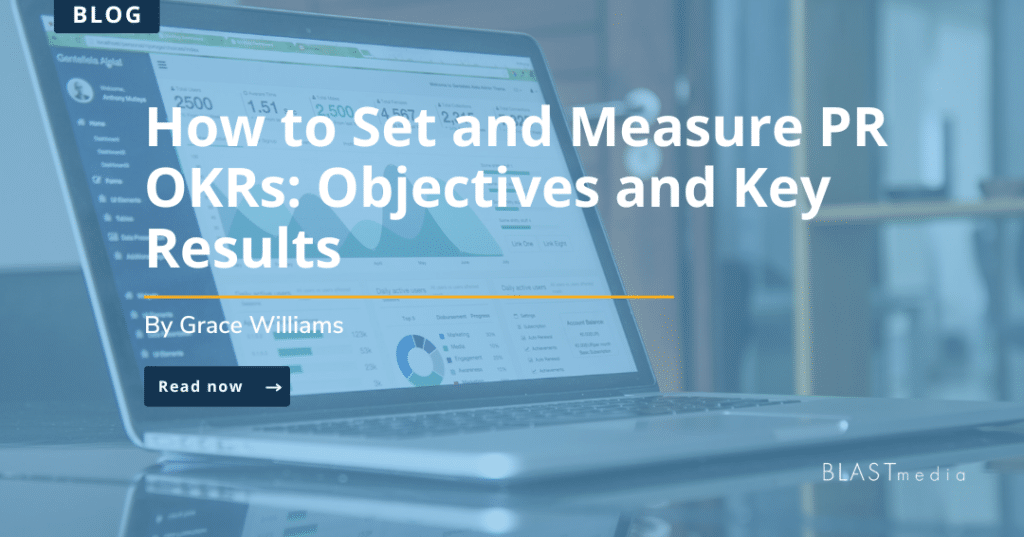
PR professionals get a bad rap for setting non-measurable goals like “increase awareness” and reporting on outdated vanity metrics like potential reach. We deserve a bit of a break — we’re top-of-funnel creatures and don’t have the luxury of making a direct impact on sales as measured by bookings or even form fills like our counterparts in demand gen. At the same time, we’re responsible for coming up with impactful goal-setting mechanisms that help our peers in marketing understand the value of PR.
That’s why our agency, like many of our clients, uses the objectives and key results (OKR) framework to guide our goal setting. Before I dive into how to set PR OKRs for your business, a bit of background might be helpful.
Where did OKRs come from?
Created by Andy Grove at Intel and later evangelized by venture capitalist John Doerr (who literally wrote the book on OKRs), OKRs have been adopted by many mega-successful companies like Allbirds, Google and Netflix. OKRs include both overarching objectives (O) as well as specific key results (KR). OKRs should be collaborative, ambitious and measurable. They allow you to transparently track goal progress and create alignment between individuals and their managers or between teams.
What is an OKR?
Objectives are the ultimate goal — what are we working toward? And KRs are how we get there. According to a pretty good breakdown on Measure What Matters, “Effective KRs are specific and time-bound, aggressive yet realistic. Most of all, they are measurable and verifiable. You either meet a key result’s requirements or you don’t; there is no gray area, no room for doubt. At the end of the designated period, typically a quarter, we do a regular check and grade the key results as fulfilled or not.”
How do OKRs work in SaaS PR?
In an ideal world, the objectives your PR team is working toward come from your own marketing team’s existing OKRs or goals. PR activities shouldn’t exist in a silo; they should map to overarching marketing and business objectives. When we first start with a client, we ask to see their team’s OKRs and begin with those objectives as our foundation.
That could be anything from building a category, increasing awareness, driving inbounds/leads, establishing a thought leadership platform, or positioning against a competitor. We like to have no more than 3 objectives for each client each quarter, with 3-5 key results per objective. Below are a few examples (not an exhaustive list) of the types of KRs we might slot under each category.
Sample OKRs
Awareness
- Pieces of coverage
- Reach of coverage / UVM
- Number of announcements per quarter
- Submit for # awards and/or speaking opportunities
Building or leading a category / repositioning
- # pieces of coverage including a specific key message
- # pieces of coverage in specific vertical
- Leveraging a customer use case that demonstrates expertise in vertical/category
- Secure # analyst briefings
Inbound leads / opportunities/SEO/traffic
- # of backlinks
- # of referral visitors to website
- PIeces of coverage that are driving traffic to website
- Average Domain Authority of coverage
Thought leadership
- # of pieces of contributed content
- # of quotes / interviews / podcasts
- Coverage for certain spokespeople
- Submit for # speaking opportunities
Position against a competitor
- Share of voice percentage maintenance or increase
- Coverage quality comparison
- Submit for # awards competitors have previously won
- Issue # releases around competitive differentiators
Monitoring and measuring PR OKRs
Once you’ve established OKRs, regular check-ins are essential. At our agency, we include OKRs and current status on every bi-weekly check-in. In addition to updated numbers, we list a confidence level. On a scale from 1-10, how confident are we that we will achieve the KR? If we’re in the second half of the quarter, and confidence levels are below 5, we strongly consider changing our goal-setting methodology.
In our frame of reference, OKRs should be set as stretch goals with a completion rate around 70%. If we’re exceeding each KR, we know our goals aren’t ambitious enough. We rank OKRs according to this measurement:
- 100% completion or more (We knocked it out of the park.) | Exceeded
- 70% to 99% completion (We delivered.) | Good
- 40% to 69% completion (We made progress, but fell short of completion.) | Progressed
- 0% to 39% completion (We failed to make real progress.) | Unmet
This goal-setting format holds us accountable to achieving results–yes–but not just any results. Results that map to your specific marketing objectives, and hopefully have a measurable impact on your brand. No two sets of OKRs across our client roster look the same because no two PR programs look the same. While establishing a regular press release cadence may be important for Company A leading up to an IPO, that same KR could be meaningless to Company B, which operates in a space with little to no news activity.
Bottom line: SaaS PR professionals must grow their measurement criteria beyond vanity metrics. PR OKRs are our answer to the age-old question of how to measure the success of a media relations program.
